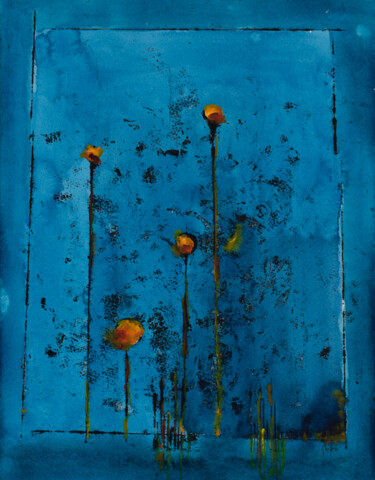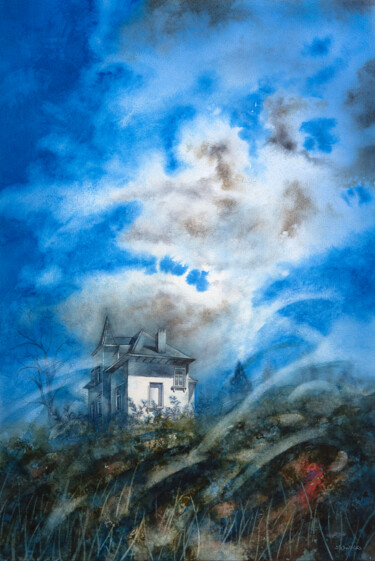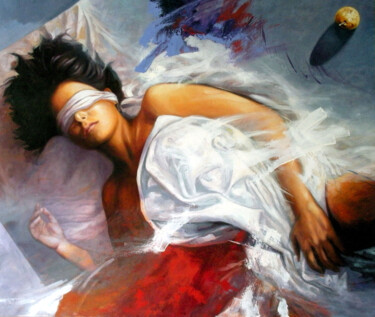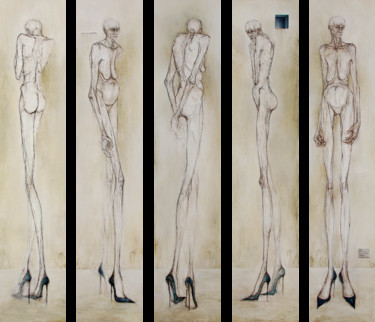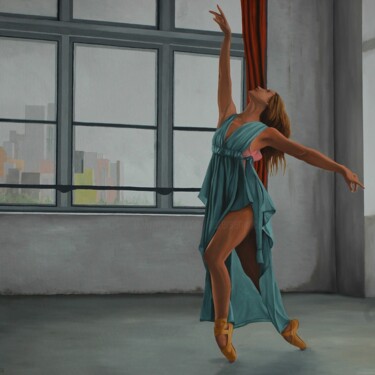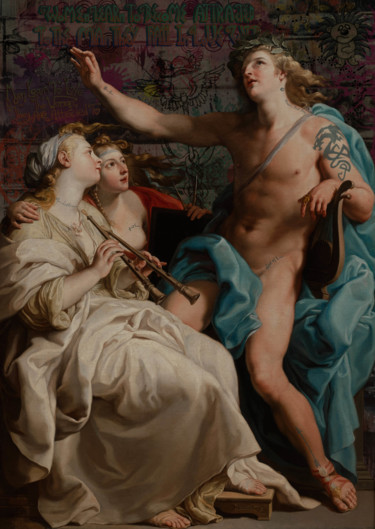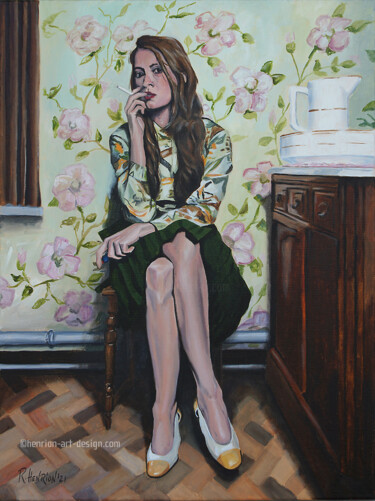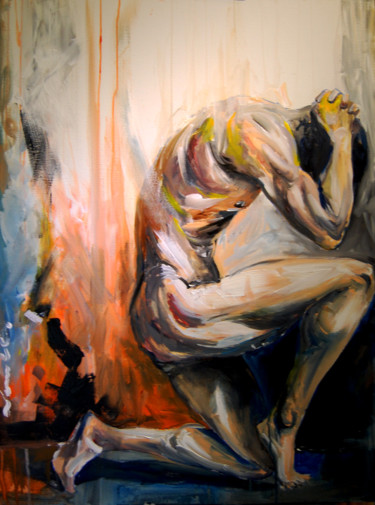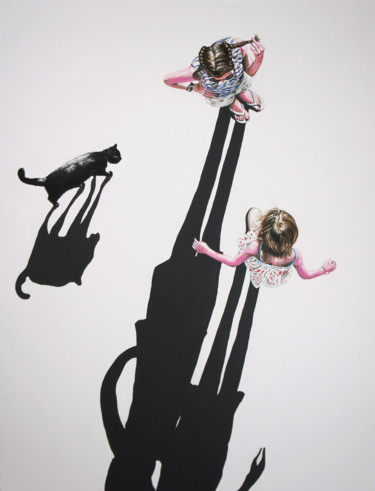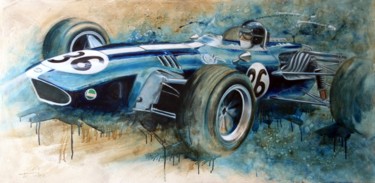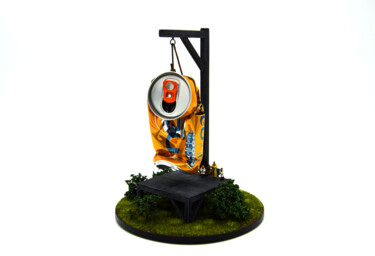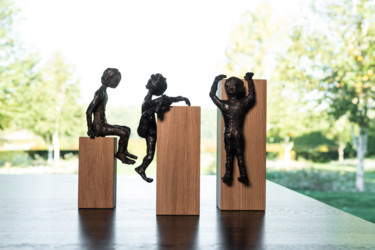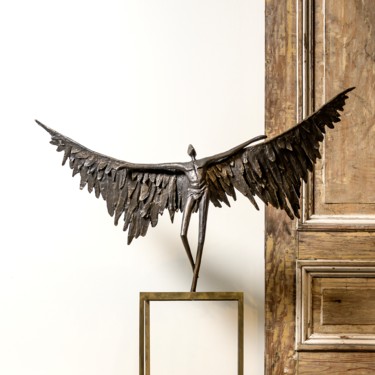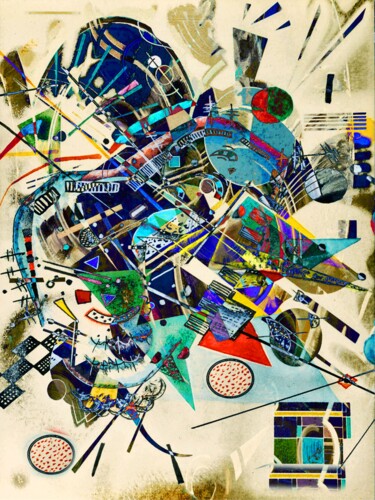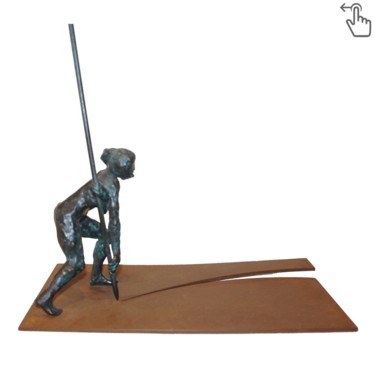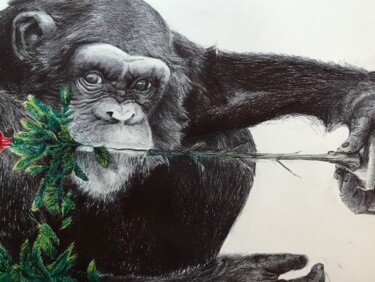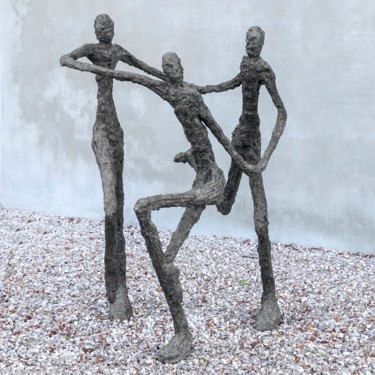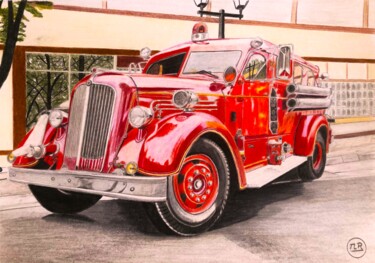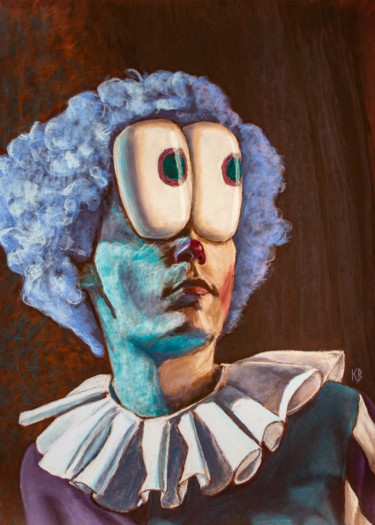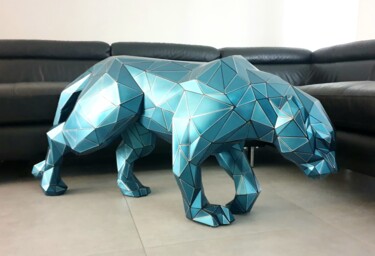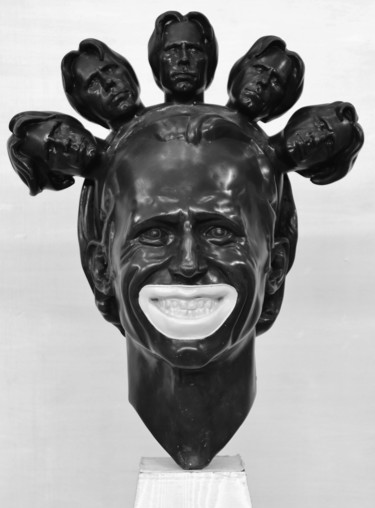 Emily Coubard (Mil.), Gaze, 2022. Collage on canvas, 30 x 30 cm.
Emily Coubard (Mil.), Gaze, 2022. Collage on canvas, 30 x 30 cm.
Flemish painting revealed by Jan Van Eyck's Madonna of Chancellor Rolin
To recount how the art of Belgium has exerted its influence within the history of Western art, the description of its best-known masterpieces, exemplifying those revolutionary stylistic features that have indelibly marked the peculiarities of the most popular forms of figurative expression of all time, might suffice. Following this insight, it is impossible not to refer to Jan Van Eyck's Madonna of the Chancellor Rolin, an iconic work of Flemish painting from 1436 preserved in the Louvre Museum in Paris. The painting was made for the Chancellor of Burgundy and Brabant Nicolas Rolin, who is portrayed on the left side of the panel kneeling before the Virgin, who, with the Child on her knees, is depicted giving her back to an angel in flight, intent on supporting the weight of an elaborate crown. This scene finds its setting in a room skillfully constructed in accordance with the principles of linear perspective, richly decorated and bordered by an elegant classical colonnade, overlooking an enclosed garden, probably intended to symbolize the concept of Hortus conclusus, or that typical form of medieval green space, used to house the medicinal, or food plants and trees grown in monasteries and convents.
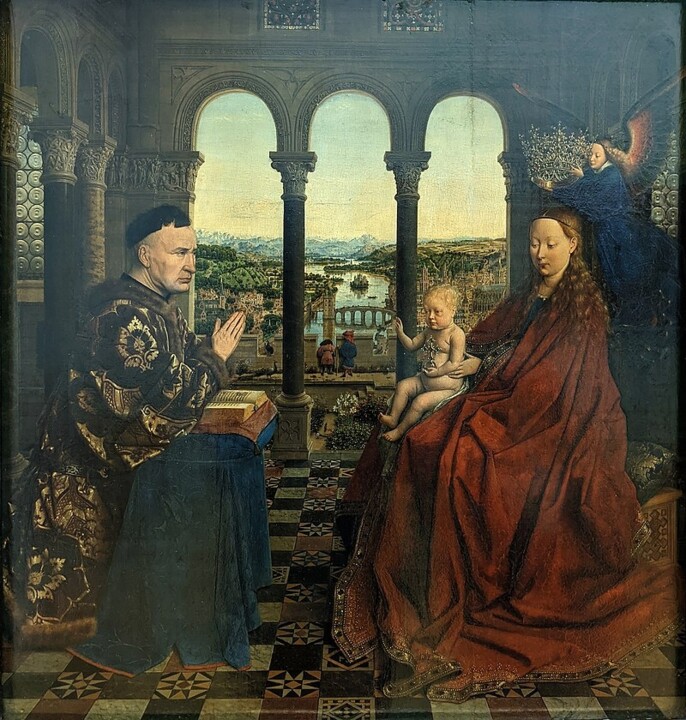 Jan Van Eyck, Madonna of the Chancellor Rolin, 1435 ca. Oil on panel, 66 x 62 cm. Louvre Museum, Paris.
Jan Van Eyck, Madonna of the Chancellor Rolin, 1435 ca. Oil on panel, 66 x 62 cm. Louvre Museum, Paris.
 Serge Broeders, The chair with the drape, 2020. Oil on linen canvas, 100 x 100 cm.
Serge Broeders, The chair with the drape, 2020. Oil on linen canvas, 100 x 100 cm.  Mc_garbage, Nathan road. Oil on canvas, 100 x 100 cm.
Mc_garbage, Nathan road. Oil on canvas, 100 x 100 cm.
Brief history of Flemish painting
The aforementioned masterpiece by Jan Van Eyck introduces us to the heart of Flemish painting, a school of 15th-century origin that assumed a fundamental role in European art history during the 15th, 16th, and 17th centuries. Within this long span of time, three fundamental phases of the aforementioned type of artistic investigation can be distinguished: that of the Flemish Primitives (15th), the High Renaissance, and the Baroque. The former, indelibly linked to the names of great masters such as Jan Van Eyck, Rogier van der Weyden, and Robert Campin, was mainly explicated through the production of paintings with religious themes, accompanied by a keen interest in the genre of portraiture and landscape backgrounds. Such an approach to art strongly influenced European painting of those same years, which, "aping" the Flemish, began to adopt similar stylistic tendencies, as well as the use of oil painting in place of tempera painting. Speaking of the Flemish Renaissance (15th-16th), the artistic production of this period turns out to be predominantly influenced by Italian art and culture, which came to Flanders through painted tapestry cartoons, engravings and prints, which were sent to northern Europe by masters from the Bel Paese. Despite the strong Italic influence, in these same years there were also Flemish masters, who continued to follow the local figurative tradition and, more extensively, the northern European one as well, expressing themselves through rather original and innovative stylistic features, just as the work of Hieronymus Bosch and Pieter Brueghel the Elder demonstrates. With regard to the Baroque period (16th-17th), it was the Flemish Rubens, the most influential painter of the early 17th century, who best expressed the trends of this movement, of which he was one of the first masters to encourage its development, popularity and spread. Finally, it is worth pointing out how the term Flemish is not limited to a figurative culture originating exclusively from what is now Belgium, as this expression is indelibly linked to the historical region of Flanders, an area, which, at the time of the aforementioned masters, was also inclusive of regions in the Netherlands and northern France.
 Michel Leclercq, Opaline n°2, 2016. Oil on canvas, 100 x 80 cm.
Michel Leclercq, Opaline n°2, 2016. Oil on canvas, 100 x 80 cm.
 Régis Gomez., Paradise, 2020. Sculpture, resin / wood / wire / metals / plastic / sand on wood, 21, 5 x 23 x 23 cm.
Régis Gomez., Paradise, 2020. Sculpture, resin / wood / wire / metals / plastic / sand on wood, 21, 5 x 23 x 23 cm.
Belgian art: a focus on contemporaneity
Although the Flemish school represents a timeless classic, often associated with the highest form of expression in Belgian art, it should be more explicitly stated how this small country has continued to influence the art world thereafter, offering the viewpoints of great masters, such as, for example, James Ensor (1860-1949), Paul Delvaux (1897-1989), and René Magritte (1898-1967). In addition, that creative narrative continues into the contemporary, just as the viewpoints of Dirk Braeckman, Pierre Alechinsky, Michael Borremans, and Ann Veronica Janssens demonstrate, as well as those of Artmajeur artists, including Anne Platbroot, Katya M, and Le Closier.
 Anne Platbroot, Serena cat, 2021. Sculpture, ceramic on other substrate, 26 x 13 x 1 / 1.90 kg.
Anne Platbroot, Serena cat, 2021. Sculpture, ceramic on other substrate, 26 x 13 x 1 / 1.90 kg.
Anne Platbroot: Serena cat
The elegant and refined Miss Serena, an anthropomorphic cat wearing the clothes of the most luxurious Renaissance tradition, imposes herself in the space with an obvious expression of serenity, lightheartedness, confidence and nonchalance, which shines through her dark face, in stark "contrast" with the grandeur and seriousness of her long and voluminous white ceramic skirt. However, this regal image, which reminds us of a noblewoman of bygone days caught in a moment of playful strolling, has been enriched by an accurate contemporary detail: the pockets of the dress, in which the animal can conceal, in part, its identity somewhere between woman and feline. Referring to the artist's statements, however, this particular model, whose clothing is worthy of Pieter Brueghel the Elder's time, would have been made drawing inspiration from Jacques Demy's film The Wonderful Tale of Donkey Skin, in which a stunning Catherine Deneuve wears a donkey skin to create a new identity for herself in order to escape an incestuous marriage with her father. Consequently, it is plausible to think that Serena the cat, like Donkey Skin, is meant to allude to a character worthy of the world of fairy tales, place where expectation is never disappointed.
 Katya M, Table lamp - Katya M., 2021. Design, 23,5 x 25 cm.
Katya M, Table lamp - Katya M., 2021. Design, 23,5 x 25 cm.
Katya M: Table lamp – Katya M.
Related to the world of fairy tales also turns out to be the reality that lies somewhere between the naive and Surrealism, well expressed by the Katya M design object, traced back to a great figurative tradition of Belgium, concretized through the work of icons of the caliber of Magritte and Mesens. Indeed, the Belgian Surrealist movement, often "marginalized" compared to its French counterpart, is the result of an extremely compelling history, as it is complex, contradictory and problematic. Precisely, Belgium's Surrealism was born out of a strong dissent, expressed when, in 1924, through the publication of the periodical Correspondance, Camille Goemans, Marcel Lecomte and Paul Nougé took a spirited stand against the "cousin" ideologies coming from Paris. The "protests" of these three literati were soon joined by other artists, such as E.L.T Mesens, Marcel Mariën and the iconic René Magritte, whose production, united by a fusion of reality and the unconscious, was distinguished for the purpose of pursuing the goal of generating eccentric-looking creatures and visions, as well as illogical scenes, designed to destabilize the viewer. In this context, the more "pro-French" viewpoints tend to consider only the figure of Magritte, claiming that the latter became a leading member of the movement only after he left Brussels for Paris. In fact, the artist, once he returned to his native country in 1930, painted almost half of his works. Therefore, Artmajeur's artist remake finds its place within great tradition, which deserves to be better investigated, disseminated, publicized and highlighted, pursuing the goal of breaking down all sorts of prejudices.
 Le Closier, Lovers, 2021. Acrylic on canvas, 76.2 x 76.2 cm.
Le Closier, Lovers, 2021. Acrylic on canvas, 76.2 x 76.2 cm.
Le Closier: Lovers
Lovers, a colorful acrylic on canvas, seems to borrow the garish colors and Pop poetics in order to transform a well-known masterpiece of art history into an attractive artistic "product," aimed at enchanting the masses on par with the most celebrated media phenomena. Magritte's work is, for all intents and purposes, a "must" of Western figurative production, which no art lover can afford not to know, contemplate, and, consequently, idolize as an icon. Such devotion is due not only to the eccentric image of the two covered faces in the act of kissing, but also to the very meaning of The Lovers, which can be traced, both to the tale of an ambiguous love story and that of a misfortune. Indeed, the peculiarities of this canvas could also represent a kind of allusion to the artist's adolescent trauma, who, when she was only fourteen years old, lost her mother. The very latter, who threw herself into a river, was later found with a nightgown over her head. In any case, despite the fact that the aforementioned association is more or less plausible, the impossibility of love inherent in the work remains certain, as white sheets prevent the actual meeting between the two lovers, who will remain forever in suspense, arousing in the viewer a conflict between what is visible and hidden, as well as between what is possible and what is not.

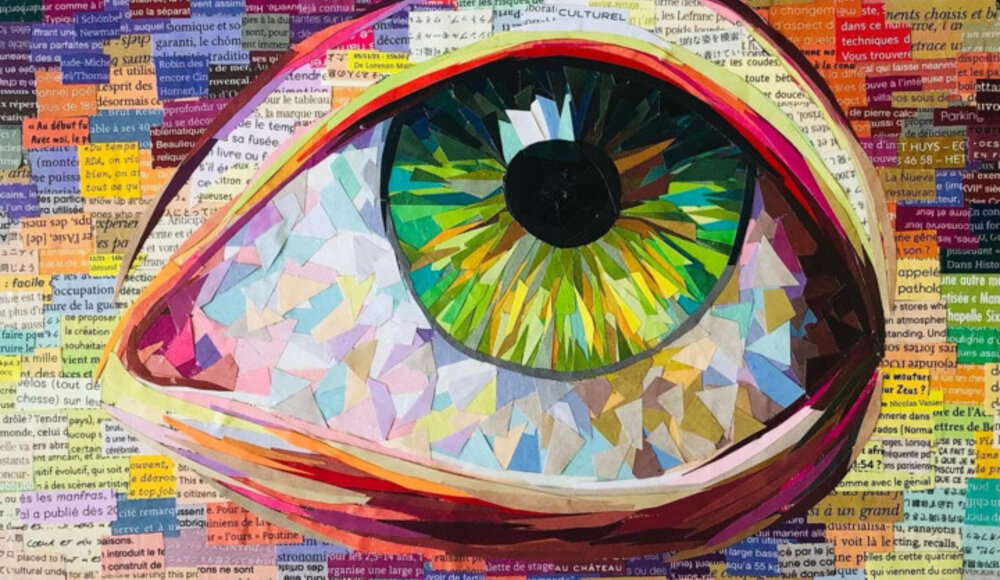
 Olimpia Gaia Martinelli
Olimpia Gaia Martinelli
